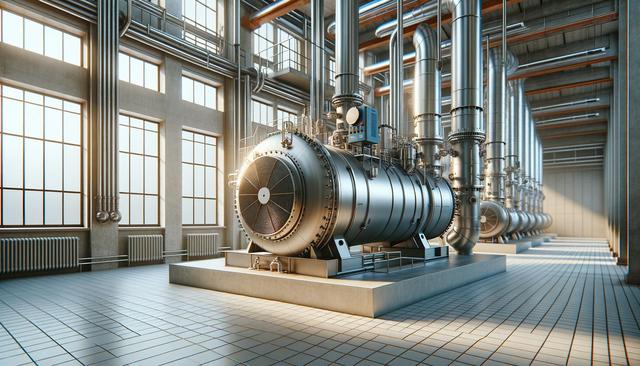Understanding High-Temperature Industrial Heat Pumps
High-temperature industrial heat pumps are advanced thermal systems designed to recover, upgrade, and redistribute heat for industrial applications that require elevated temperatures. These systems typically operate at temperature levels significantly higher than conventional heat pumps—often exceeding 100°C and reaching up to 200°C or more. Their ability to generate such high temperatures makes them particularly valuable in sectors where waste heat recovery and energy efficiency are critical.
The core principle of these heat pumps involves capturing waste heat from industrial processes, such as exhaust gases or cooling water, and elevating its temperature using thermodynamic cycles. This recovered heat can then be reused in processes like drying, sterilization, pasteurization, or steam generation. The result is a considerable reduction in energy consumption and greenhouse gas emissions, aligning with sustainability goals and improving operational cost efficiency.
Key Applications in Industrial Sectors
High-temperature industrial heat pumps have a wide range of applications across various industries. Their ability to deliver consistent and efficient heat at elevated temperatures makes them suitable for processes that traditionally rely on fossil fuel-based boilers or direct electric heating. Some of the most prominent applications include:
- Food and Beverage Industry: Used for pasteurization, sterilization, and drying processes.
- Chemical Manufacturing: Supports distillation, evaporation, and process heating.
- Pulp and Paper Sector: Enhances drying and pulp processing stages.
- Textile Industry: Provides heat for dyeing and drying operations.
In each of these sectors, the implementation of high-temperature heat pumps not only reduces dependence on traditional heating systems but also promotes circular energy flows by reusing heat that would otherwise be wasted. This leads to both environmental benefits and long-term cost savings.
Technology and Working Principles
The operation of high-temperature industrial heat pumps is based on established thermodynamic cycles, including vapor compression and absorption cycles. However, achieving higher temperatures requires specialized working fluids (refrigerants) and components that can withstand increased pressure and thermal stress. Some systems are designed with cascade configurations or hybrid setups to push thermal limits while maintaining operational safety and efficiency.
Key components of these systems include:
- High-efficiency compressors
- Advanced heat exchangers capable of handling high temperatures
- Durable refrigerants with suitable thermodynamic properties
Furthermore, control systems play a crucial role in optimizing performance, ensuring that the heat pump adapts dynamically to changing load conditions and heat source availability. As a result, modern high-temperature heat pumps are not only reliable but also flexible enough to integrate into complex industrial workflows.
Benefits and Efficiency Gains
One of the primary drivers for adopting high-temperature industrial heat pumps is the potential for substantial energy savings. By utilizing waste heat that would otherwise be lost, these systems significantly reduce the need for primary energy sources. This contributes to improved energy efficiency and a lower carbon footprint—key objectives for industries aiming to meet stricter environmental regulations.
Some notable benefits include:
- Improved overall system efficiency
- Reduced operational costs over time
- Lower emissions and environmental impact
- Enhanced energy security by reducing dependence on fossil fuels
While the initial investment in high-temperature heat pump technology can be higher than for traditional systems, the return on investment is often realized within a few years due to energy savings and potential incentives for implementing low-carbon technologies. As energy prices continue to fluctuate, the economic case for these systems becomes even more compelling.
Integration and Future Outlook
The integration of high-temperature heat pumps into existing industrial infrastructures can be streamlined with proper planning and engineering. Many systems are modular and designed to retrofit or complement current heating solutions, allowing for gradual transitions rather than complete overhauls. This flexibility makes them accessible even to facilities with limited capacity for major upgrades.
Looking forward, the development of new refrigerants with low global warming potential (GWP), along with advancements in materials and digital control technologies, is expected to further enhance the performance and adoption of high-temperature industrial heat pumps. As industries move toward decarbonization, these systems will likely play a pivotal role in energy transition strategies across the globe.
Furthermore, policy frameworks and incentives supporting energy efficiency and carbon reduction are increasing in many regions, encouraging manufacturers to explore these technologies. As a result, high-temperature heat pumps are not only a technical solution but also a strategic investment in the future of industrial energy systems.
Conclusion: Embracing Efficient Heat Solutions
For industrial operators seeking efficient, sustainable, and future-ready thermal energy solutions, high-temperature heat pumps offer a compelling option. Their ability to recover and upgrade waste heat for reuse in demanding processes supports both environmental goals and economic performance. With a growing focus on energy efficiency and carbon reduction, these systems are well-positioned to become integral components of modern industrial operations. Embracing this technology can help industries advance toward more resilient and responsible production practices.




Leave a Reply